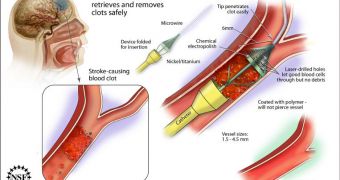Strokes can have debilitating consequences on the human body, and one of the most dangerous is the formation of blood clots inside vessels in the brain. Cerebral blood flow is considerably impaired during and after such an incident, and experts say that in excess of a million nerve cells die each minute. This happens mostly due to starvation, caused by the fact that nutrient-rich blood can no longer reach these cells. But scientists at the Sacramento, California-based Insera Therapeutics, Inc. managed to develop a new way of fighting against established blood clots.
With funding secured via the US National Science Foundation's (NSF) Small Business Innovation Research (SBIR) program, experts at Insera were able to develop a system called Stroke Help. Underlying the new approach is an Endo-Luminal Transcatheter Embolus Retrieval (SHELTERTM) device, which is a machine that can pierce holes through cloths, and then dismember them while inside the vein. This restores circulation to the affected portion of the brain, all while allowing surgeons to be as minimally invasive as possible in their procedures.
The main tool in the new approach is an especially-designed lengthy catheter, which was constructed by brothers Vallabh and Vikram Janardhan. The former is an interventions neurologist, while the other is an engineer, and also the CEO of Insera. Together, they were able to design this system in a way that combines both an outer sheath and an inner mesh. The protective layer on top is also used to capture the pieces of clot that come loose during the catheter's operations, and it also houses the nickel-titanium mesh. One of the most impressive features about this device is that it's collapsible and also just five millimeters in diameter. The tip of the mesh is covered in a soft polymer, to ensure that SHELTERTM does not accidentally pierce though the blood vessel walls.
“At the end of the day, ischemic strokes are simply a clog in a pipe. But such strokes are the leading cause of long-term disability in the United States. We ought to be able to leverage innovative technology to successfully treat this medical emergency,” explains Vikram Janardhan. “Blood clots and blood vessels are not all the same size and shape, so a one-size-fits-all removal device is not the best solution. Personalized medicine is driving many new innovations, and Insera's approach follows this trend – they found a way to bring personalization to a potentially powerful treatment approach, and we're proud to have been a small part of this effort,” concludes NSF program director Greg Baxter, who was in charge of keeping an eye on how Insera experts used the Foundation's money.

 14 DAY TRIAL //
14 DAY TRIAL //